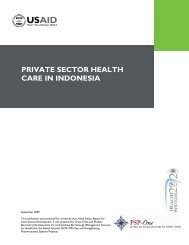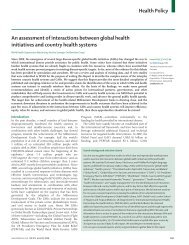southern sudan health system assessment - Health Systems 20/20
southern sudan health system assessment - Health Systems 20/20
southern sudan health system assessment - Health Systems 20/20
You also want an ePaper? Increase the reach of your titles
YUMPU automatically turns print PDFs into web optimized ePapers that Google loves.
figures into account and using a population base of 10 million, it is estimated that US$ 13 per capita was<br />
budgeted (though not necessarily disbursed) for <strong>health</strong> in <strong>20</strong>06 (see Figure 3). If these funds were all<br />
disbursed, this level of funding would be significantly more than many countries with similar per capita<br />
gross domestic product, especially among post-conflict countries. But a challenge faced by the MoH is to<br />
effectively coordinate those funds to ensure efficient use of resources. While this needs the<br />
commitment and cooperation of bilateral donors, NGOs, and UN agencies, the current needs are vast<br />
and beyond what is currently available.<br />
FIGURE 3: HEALTH SPENDING PER CAPITA IN <strong>20</strong>06 (US$)<br />
45<br />
40<br />
35<br />
30<br />
$US per capita<br />
25<br />
<strong>20</strong><br />
15<br />
10<br />
Southern Sudan<br />
<strong>20</strong>06 estimate<br />
5<br />
0<br />
0 100 <strong>20</strong>0 300 400 500 600 700 800 900 1000<br />
per capita GDPt <strong>20</strong>00 ($US)<br />
The GoSS has declared that basic <strong>health</strong> and emergency services should be provided free of charge to all<br />
Southern Sudanese citizens. This declaration applies to all public facilities as well as NGO providers.<br />
However, our interviews with state officials and NGO representatives indicate that out-of-pocket<br />
expenses are commonplace.<br />
The World Bank estimates that government expenditure on <strong>health</strong> as a percentage of total public<br />
spending is approximately 8 percent, which is on par with other sub-Saharan countries.(World Bank<br />
<strong>20</strong>07) As Southern Sudan is emerging from a long history of civil war, <strong>health</strong> indicators are still markedly<br />
inferior than for the sub-Saharan region, despite the level of <strong>health</strong> spending.<br />
Many officials interviewed attributed Southern Sudan’s poor performance relative to sub-Saharan Africa<br />
as follows:<br />
1. The GoSS did not fulfill its pledge for Phase 1 of the project. US$ 8 million was deposited in the<br />
MDTF account of the US$ 40 million pledged.<br />
2. The NGO sector is providing care inefficiently, in an ad hoc and often vertical manner.<br />
3. Unit costs in Southern Sudan are much higher than in most neighboring countries.<br />
4. MoH resources have not been strategically allocated to strengthen PHC: “specialized materials and<br />
supplies” absorbed two-thirds of non-salary recurrent costs, and “scholarships” and “training”<br />
account for half of the remainder (World Bank <strong>20</strong>07).<br />
23
















